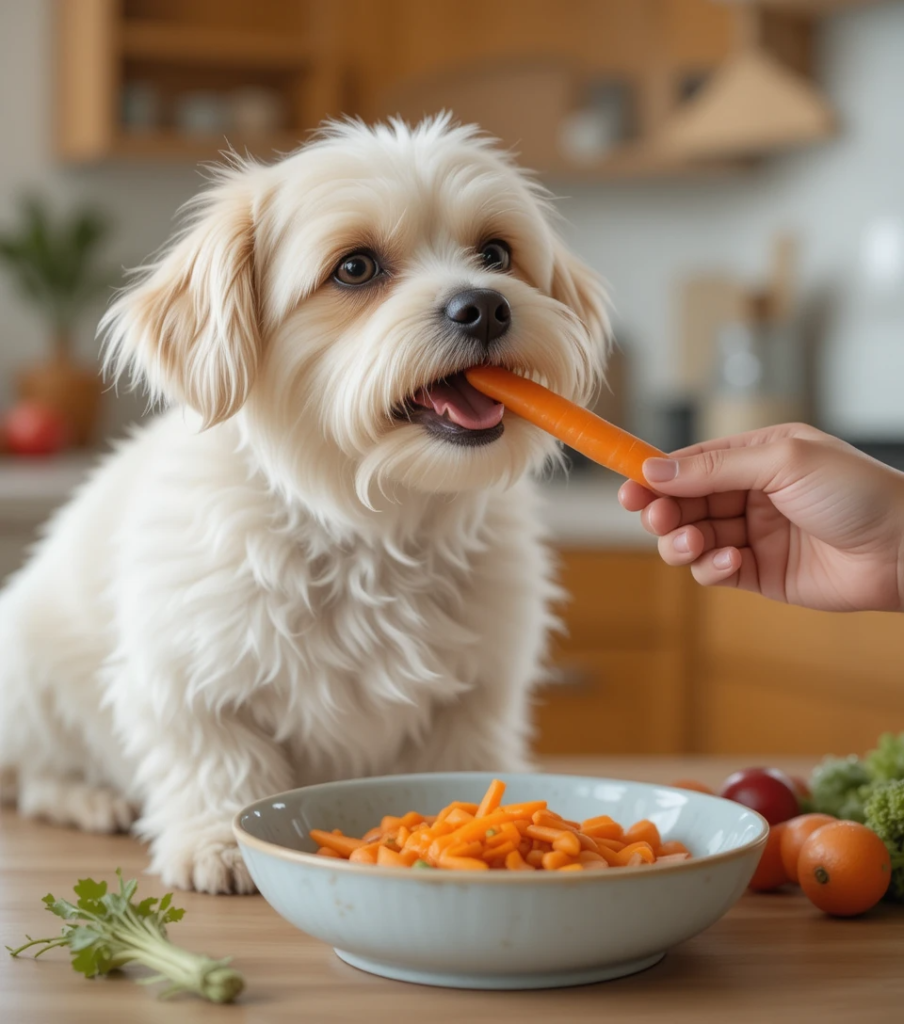Dogs thrive on love, play, and good food — and when it comes to the latter, veterinarians are increasingly recommending vegetables as part of a balanced, healthy diet. Whether you’re topping off kibble or crafting homemade meals, the right veggies can offer a natural boost to your dog’s health and happiness. In this guide, we’ll explore the vegetables dogs can eat that vets absolutely love, why they matter, how to serve them safely, and what to avoid.
🐶 Why Dogs Benefit from Vegetables

While dogs are omnivores and get most of their nutrition from meat, vegetables offer essential vitamins, minerals, antioxidants, and fiber that support overall health. Vets often recommend certain vegetables for dogs who need:
- Weight control
- Digestive support
- Boosted immunity
- Natural hydration
- Antioxidant-rich food sources
Unlike processed treats, vegetables are low in calories, rich in nutrients, and easy on the digestive system when prepared properly.
🥕 Top Vet-Approved Vegetables for Dogs
Here are the top vegetables veterinarians absolutely love and approve for canine consumption:
1. Carrots
- High in beta-carotene and fiber
- Great for teeth and vision
- Crunchy texture dogs enjoy raw or cooked
2. Green Beans
- Low in calories, rich in iron and vitamins
- Excellent for overweight dogs
- Can be steamed or served plain
3. Sweet Potatoes
- Packed with antioxidants and vitamin A
- Ideal for digestive health and energy
- Serve mashed, baked, or steamed (no seasoning)
4. Pumpkin (Plain, Cooked)
- Great for regulating digestion
- Contains beta-carotene and fiber
- Helps with both constipation and diarrhea
5. Peas (Green, Snow, Snap)
- Rich in B vitamins and protein
- Often found in high-end dog foods
- Serve fresh or steamed, not canned
6. Zucchini
- Low in calories and high in fiber
- Easy to digest
- Tastes mild and blends well in food
7. Broccoli (in moderation)
- High in vitamin C and fiber
- Best cooked or lightly steamed
- Avoid overfeeding to prevent gas
8. Cucumber
- High water content = hydration booster
- Great for overweight dogs as a low-calorie snack
- Serve in small, thin slices
9. Spinach (limited amounts)
- Contains iron, antioxidants, and vitamins
- Best served steamed to reduce oxalates
🔪 Raw vs. Cooked: What’s Better for Dogs?
Cooking vegetables can soften tough fibers, making them easier for dogs to digest — especially in the case of carrots, sweet potatoes, and spinach. However, some veggies (like cucumbers and zucchini) can be served raw for a crunchy snack.
✅ Safe Cooking Methods:
- Steaming
- Boiling (unsalted)
- Baking (no oils or seasoning)
- Pureeing
Avoid frying or using butter, garlic, onions, salt, or other seasonings, as they can be toxic or cause digestive upset.
🚫 Vegetables to Avoid Completely
Not all vegetables are safe. Vets strongly warn against the following:
- Onions and Garlic – Can cause anemia
- Mushrooms – Many wild types are toxic
- Avocados – Contain persin, harmful to dogs
- Rhubarb – Can affect the nervous system
- Tomatoes (green or unripe) – Contain solanine, which is toxic
If you’re unsure, always check with your vet before adding a new vegetable to your dog’s diet.
🐾 How to Introduce Veggies to Your Dog’s Diet

Start slowly and watch for any signs of allergies or digestive issues like gas, bloating, or diarrhea.
Tips:
- Chop veggies into small pieces
- Mix with regular food or treats
- Start with a small serving once a day
- Rotate vegetables for a balanced nutrient profile
⚖️ Portion Control & Feeding Guidelines
Vegetables should only make up 10–20% of your dog’s total daily diet. The rest should come from high-quality protein, fats, and essential nutrients — either via complete dog food or a vet-approved homemade diet.
Portion Tips by Dog Size:
- Small dogs: 1–2 tbsp of veggies/day
- Medium dogs: ¼ cup/day
- Large dogs: up to ½ cup/day
Always adjust based on your dog’s weight, age, and activity level.
🩺 Vet Testimonials & Professional Insights
“Many pet parents are surprised to learn how much dogs benefit from fiber and antioxidants found in vegetables. Used wisely, veggies are a powerful addition to your pet’s daily routine.”
— Dr. Elena B., DVM
“Carrots and green beans are two of my go-to recommendations for weight management in dogs.”
— Dr. Marcus R., Veterinary Nutritionist
Vets consistently emphasize moderation, balance, and monitoring for allergies when integrating vegetables into a dog’s diet.
🍴 Homemade Dog Treat Ideas Using Vegetables
Want to get creative? Try these healthy, vet-loved treat ideas:
- Carrot & Oat Mini Biscuits
- Pumpkin & Peanut Butter Pupsicles
- Sweet Potato Chews (Dehydrated or Baked)
- Frozen Pea & Yogurt Cubes
- Zucchini & Chicken Meatballs
These treats are easy to make, budget-friendly, and far healthier than many commercial snacks.
✅ Final Thoughts
Vegetables dogs can eat that vets absolutely love aren’t just safe — they’re beneficial, budget-friendly, and a natural way to enhance your pet’s well-being. From carrots and peas to pumpkin and sweet potatoes, these vet-approved options offer everything from digestive support to tasty treats. Just remember to avoid toxic veggies, cook when needed, and serve in moderation.
When in doubt, always check with your veterinarian. A healthy dog is a happy dog!
❓ 10 Frequently Asked Questions (FAQs)
- Can all dogs eat vegetables safely?
Not all, but many. Always check for toxicity and introduce veggies gradually. - What vegetables do vets recommend most for dogs?
Carrots, green beans, sweet potatoes, pumpkin, and peas are top favorites. - Are raw vegetables safe for dogs to eat?
Some are — like carrots and cucumbers. Others should be cooked for easier digestion. - How much vegetables should I feed my dog daily?
About 10–20% of their diet; portion based on size and health needs. - What are the healthiest vegetables for overweight dogs?
Green beans, cucumbers, zucchini, and carrots due to their low-calorie content. - Are there any vegetables that are toxic to dogs?
Yes. Avoid onions, garlic, avocados, mushrooms, and green tomatoes. - Can puppies eat vegetables too?
Yes, but only in small amounts and with vet guidance. - How should I cook vegetables for my dog?
Steam, boil, or bake them without seasoning. Avoid frying or adding oils. - Do vegetables replace dog food or just supplement it?
They supplement a balanced diet — not replace it. - What signs show a dog is allergic to a vegetable?
Watch for vomiting, diarrhea, itching, or lack of appetite.

